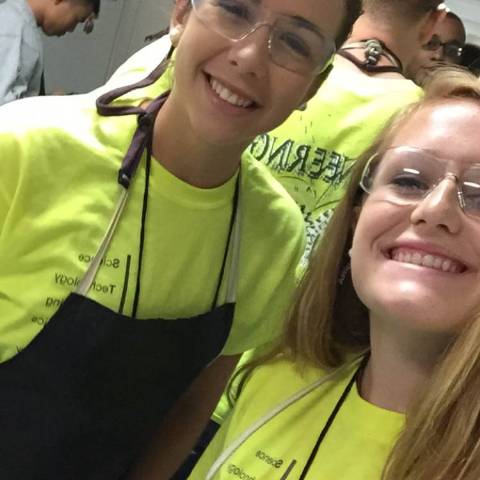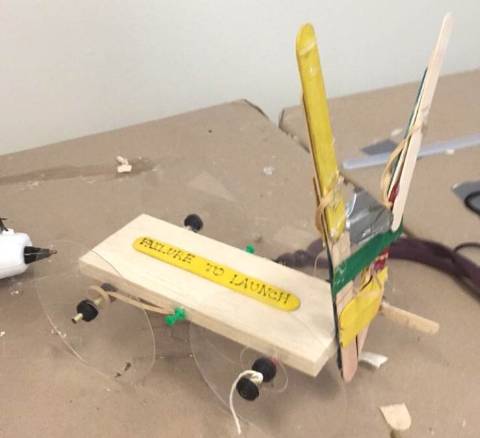

This summer, I was selected and given the opportunity to attend the United States Naval Academy's Summer STEM Program in Annapolis, Md. For a week, I was a resident in Vancroft Hall and attended classes and modules arranged by USNA professors. During the program, I designed and constructed rockets, helicopters, cars powered by rubber bands and other engineering projects (a lot of hot glue was involved; I have the scars to prove it.)
I flew into Baltimore on Monday and was escorted by a midshipman to the academy. Shortly after arriving, I received my squad assignment. For the week, I was part of Midshipman Ricke’s squad in the burgundy platoon. I spent most of the time with my squad, eating meals and attending classes as a group. Monday evening, we were given a task: to create a maze for a hex bug out of Styrofoam, balsa wood, and popsicle sticks to accumulate the most points. Though my partner and I fell short of glory, I enjoyed competing with other students and seeing how drastically different the designs were with the given restraints.
On Tuesday, we spent most of the day in Washington, D.C., where we toured the Smithsonian Air and Space and Natural History museums. My favorite part of the Air and Space museum was the IMAX Theater, not just because it was an air-conditioned opportunity to sit, but that certainly was a factor. I felt right at home in D.C. – it’s as hot and humid as Georgia.
Wednesday was our first day full of classes and projects. My group began the day in the biometrics lab, where I was able to control a computer using only my eyes. (My eyes now hold the record for paddleball on computer 3.) In another module, we constructed miniature rockets from straws and construction paper and launched them at targets. This was when I learned that I do not need to be trusted with a rocket in a science lab full of expensive equipment. Rocket science was followed by aeronautics as we built helicopters, aiming to maximize the lift while minimizing weight. I was much better at helicopter construction than rocket launching, and my group won with the most efficient helicopter.
That evening, we designed cars that were powered solely by rubber bands. The object was to release the car using the rubber bands, have it role exactly 10 feet, then launch a Ping-Pong ball as far as possible. In the four hours we were given, my group went through about six or seven different designs, finally creating our pride and joy: “Failure to Launch.” Unfortunately, the name was more prophetic than ironic as our Ping-Pong ball refused to release, so we did not take home the gold for the car competition.
By Thursday morning, my ego had recovered from the car defeat and I was ready to redeem myself. We had been asked to prepare projects and bring them with us to camp. Mrs. Dodd and I got together earlier in the month and had prepared an experiment testing the buffering capacity of different citrus drink mixes. After presenting my project to a group of fellow campers and midshipmen, I was selected to compete in the semifinals for the presentation competition. Though I advanced no further, I was honored to get a chance to view the other competitors’ projects, which included topics such as nuclear fission, artificial retinas for the blind, and plants grown out of thin air. We continued the day with more modules; I made soap and aspirin in the chemistry lab, programmed robots to fight like bulls, and viewed the world through lenses that would put a kaleidoscope to shame.
After an award ceremony Friday morning, I left Annapolis and flew back home. The camp consisted of people from all 50 states, but the friends I made were from Tennessee and Florida. During the week, I learned that my Southern accent is much stronger than I knew, and “y’all” is an amusing colloquialism. This opportunity allowed me to experience one of the best engineering programs in the country. I hope to pursue a career in medicine and major in biomedical engineering, and this program allowed me to see firsthand the applications for work I might do in the future.
Editor's Note: Click here to read the press release about Anna Katherine Cates' selection for this elite program. Despite its professional appearance, my team of three constructed this beauty using only hot glue, (again, scars) CD’s, popsicle sticks, balsa work, rubber bands, axels, and duct tape. Though admirable, her performance fell short of a victory.
Despite its professional appearance, my team of three constructed this beauty using only hot glue, (again, scars) CD’s, popsicle sticks, balsa work, rubber bands, axels, and duct tape. Though admirable, her performance fell short of a victory.